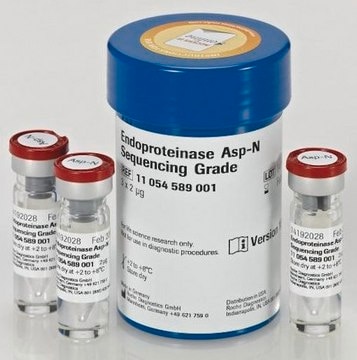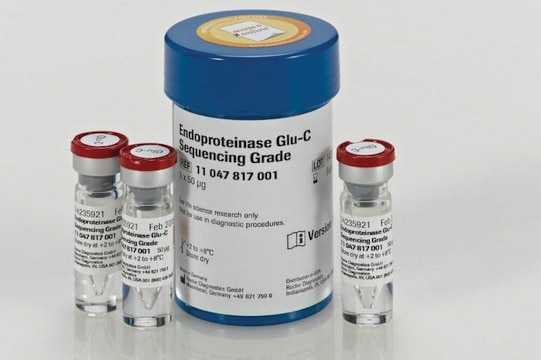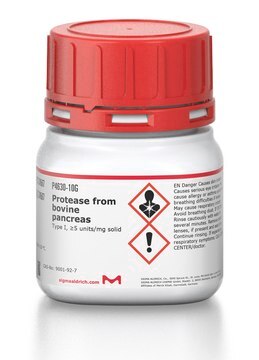Recommended Products
General description
Native endoproteinase Asp-N from Pseudomonas fragi. Designed for protein sequencing or sequence verification, analysis of protein structural domains, and cleavage of fusion proteins. Metalloprotease that specifically hydrolyzes proteins and the N-terminal side of aspartic acid and cysteic acid residues. Inhibited by aprotinin, DFP, leupeptin, and TLCK.
Native endoproteinase Asp-N from Pseudomonas fragi. Designed for protein sequencing or sequence verification, analysis of protein structural domains, and cleavage of fusion proteins. Metalloprotease that specifically hydrolyzes proteins at the N-terminal side of aspartic acid and cysteic acid residues. Inhibited by aprotinin, DFP, leupeptin, and TLCK. Suggested working concentration: 1:20 to 1:100 (protease:protein by weight) for sequence analysis.
Warning
Toxicity: Harmful (C)
Unit Definition
One unit is defined as the amount of enzyme that will release a sufficient amount of azo dye from AZOCOLL Substrate (Cat. No. 194932) to produce an increase in absorbance at 520 nm of 0.001 per min at 37°C, pH 7.5.
Physical form
Lyophilized from 10 mM Tris-HCl, pH 7.5.
Reconstitution
Following reconstitution, aliquot and freeze (-20°C) for long term storage or refrigerate (4°C) for short term storage. Stock solutions are stable for up to 2 days at 4°C or for up to 1 month at -20°C.
Other Notes
Drapeau, G.R. 1980. J. Biol. Chem.255, 839.
Legal Information
CALBIOCHEM is a registered trademark of Merck KGaA, Darmstadt, Germany
signalword
Danger
Hazard Classifications
Eye Irrit. 2 - Resp. Sens. 1 - Skin Irrit. 2 - STOT SE 3
target_organs
Respiratory system
Storage Class
11 - Combustible Solids
wgk_germany
WGK 1
Certificates of Analysis (COA)
Search for Certificates of Analysis (COA) by entering the products Lot/Batch Number. Lot and Batch Numbers can be found on a product’s label following the words ‘Lot’ or ‘Batch’.
Already Own This Product?
Find documentation for the products that you have recently purchased in the Document Library.
Our team of scientists has experience in all areas of research including Life Science, Material Science, Chemical Synthesis, Chromatography, Analytical and many others.
Contact Technical Service





